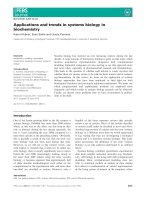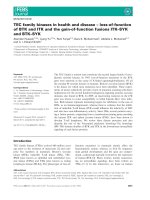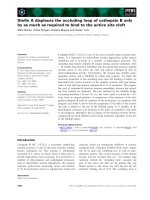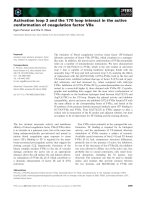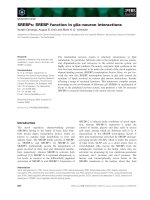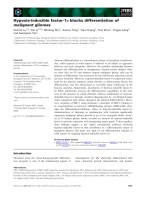Tài liệu Báo cáo khoa học: "Harnessing NLP Techniques in the Processes of Multilingual Content Management" pptx
Bạn đang xem bản rút gọn của tài liệu. Xem và tải ngay bản đầy đủ của tài liệu tại đây (370.64 KB, 5 trang )
Proceedings of the 13th Conference of the European Chapter of the Association for Computational Linguistics, pages 6–10,
Avignon, France, April 23 - 27 2012.
c
2012 Association for Computational Linguistics
Harnessing NLP Techniques in the Processes of
Multilingual Content Management
Anelia Belogay
Diman Karagyozov
Tetracom IS Ltd.
Tetracom IS Ltd.
Svetla Koeva
Cristina Vertan
Institute for Bulgarian Language
Universitaet Hamburg
Adam Przepiórkowski
Polivios Raxis
Instytut Podstaw Informatyki Polskiej
Akademii Nauk
Atlantis Consulting SA
Dan Cristea
Universitatea Alexandru Ioan Cuza
Abstract
The emergence of the WWW as the main
source of distributing content opened the
floodgates of information. The sheer
volume and diversity of this content
necessitate an approach that will reinvent
the way it is analysed. The quantitative
route to processing information which
relies on content management tools
provides structural analysis. The
challenge we address is to evolve from
the process of streamlining data to a level
of understanding that assigns value to
content.
We present an open-source multilingual
platform ATALS that incorporates
human language technologies in the
process of multilingual web content
management. It complements a content
management software-as-a-service
component i-Publisher, used for creating,
running and managing dynamic content-
driven websites with a linguistic
platform. The platform enriches the
content of these websites with revealing
details and reduces the manual work of
classification editors by automatically
categorising content. The platform
ASSET supports six European languages.
We expect ASSET to serve as a basis for
future development of deep analysis tools
capable of generating abstractive
summaries and training models for
decision making systems.
Introduction
The advent of the Web revolutionized the way in
which content is manipulated and delivered. As a
result, digital content in various languages has
become widely available on the Internet and its
sheer volume and language diversity have
presented an opportunity for embracing new
methods and tools for content creation and
distribution. Although significant improvements
have been made in the field of web content
management lately, there is still a growing
demand for online content services that
incorporate language-based technology.
Existing software solutions and services such
as Google Docs, Slingshot and Amazon
implement some of the linguistic mechanisms
addressed in the platform. The most used open-
source multilingual web content management
6
systems (Joomla, Joom!Fish, TYPO3, Drupal)
1
offer low level of multilingual content
management, providing abilities for building
multilingual sites. However, the available
services are narrowly focused on meeting the
needs of very specific target groups, thus leaving
unmet the rising demand for a comprehensive
solution for multilingual content management
addressing the issues posed by the growing
family of languages spoken within the EU.
We are going to demonstrate the open-source
content management platform ATLAS and as
proof of concept, a multilingual library i-
librarian, driven by the platform. The
demonstration aims to prove that people reading
websites powered by ATLAS can easily find
documents, kept in order via the automatic
classification, find context-sensitive content, find
similar documents in a massive multilingual data
collection, and get short summaries in different
languages that help the users to discern essential
information with unparalleled clarity.
The “Technologies behind the system” chapter
describes the implementation and the integration
approach of the core linguistic processing
framework and its key sub-components – the
categorisation, summarisation and machine-
translation engines. The chapter “i-Librarian – a
case study” outlines the functionalities of an
intelligent web application built with our system
and the benefits of using it. The chapter
“Evaluation” briefly discusses the user
evaluation of the new system. The last chapter
“Conclusion and Future Work” summarises the
main achievements of the system and suggests
improvements and extensions.
Technologies behind the system
The linguistic framework ASSET employs
diverse natural language processing (NLP) tools
technologically and linguistically in a platform,
based on UIMA
2
. The UIMA pluggable
component architecture and software framework
are designed to analyse content and to structure
it. The ATLAS core annotation schema, as a
uniform representation model, normalizes and
harmonizes the heterogeneous nature of the NLP
tools
3
.
1
2
3
The system exploits heterogeneous NLP tools, for
the supported natural languages, implemented in Java,
C++ and Perl. Examples are:
The processing of text in the system is split
into three sequentially executed tasks.
Firstly, the text is extracted from the input
source (text or binary documents) in the “pre-
processing” phase.
Secondly, the text is annotated by several NLP
tools, chained in a sequence in the “processing”
phase. The language processing tools are
integrated in a language processing chain (LPC),
so that the output of a given NLP tool is used as
an input for the next tool in the chain. The
baseline LPC for each of the supported languages
includes a sentence and paragraph splitter,
tokenizer, part of speech tagger, lemmatizer,
word sense disambiguation, noun phrase chunker
and named entity extractor (Cristea and Pistiol,
2008). The annotations produced by each LPC
along with additional statistical methods are
subsequently used for detection of keywords and
concepts, generation of summary of text, multi-
label text categorisation and machine translation.
Finally, the annotations are stored in a fusion
data store, comprising of relational database and
high-performance Lucene
4
indexes.
The architecture of the language processing
framework is depicted in Figure 1.
Figure 1. Architecture and communication channels in
our language processing framework.
The system architecture, shown in Figure 2, is
based on asynchronous message processing
OpenNLP (
RASP (
Morfeusz ( Panterra
( ParsEst
( TnT Tagger (-
saarland.de/~thorsten/tnt/).
4
7
patterns (Hohpe and Woolf, 2004) and thus
allows the processing framework to be easily
scaled horizontally.
Figure 2. Top-level architecture of our CMS and its
major components.
Text Categorisation
We implemented a language independent text
categorisation tool, which works for user-defined
and controlled classification hierarchies. The
NLP framework converts the texts to a series of
natural numbers, prior sending the texts to the
categorisation engine. This conversion allows
high level compression of the feature space. The
categorisation engine employs different
algorithms, such as Naïve Bayesian, relative
entropy, Class-Feature Centroid (CFC) (Guan et.
al., 2009), and SVM. New algorithms can be
easily integrated because of the chosen OSGi-
based architecture (OSGi Alliance, 2009). A
tailored voting system for multi-label multi-class
tasks consolidates the results of each of the
categorisation algorithms.
Summarisation (prototype phase)
The chosen implementation approach for
coherent text summarisation combines the well-
known LexRank algorithm (Erkan and Radev,
2004) and semantic graphs and word-sense
disambiguation techniques (Plaza and Diaz,
2011). Furthermore, we have automatically built
thesauri for the top-level domains in order to
produce domain-focused extractive summaries.
Finally, we apply clause-boundaries splitting in
order to truncate the irrelevant or subordinating
clauses in the sentences in the summary.
Machine Translation (prototype phase)
The machine translation (MT) sub-component
implements the hybrid MT paradigm, combining
an example-based (EBMT) component and a
Moses-based statistical approach (SMT). Firstly,
the input is processed by the example-based MT
engine and if the whole or important chunks of it
are found in the translation database, then the
translation equivalents are used and if necessary
combined (Gavrila, 2011). In all other cases the
input is processed by the categorisation sub-
component in order to select the top-level
domain and respectively, the most appropriate
SMT domain- and POS-translation model
(Niehues and Waibel, 2010).
The translation engine in the system, based on
MT Server Land (Federmann and Eisele, 2010),
is able to accommodate and use different third
party translation engines, such as the Google,
Bing, Lusy or Yahoo translators.
Case Study: Multilingual Library
i-Librarian
5
is a free online library that assists
authors, students, young researchers, scholars,
librarians and executives to easily create,
organise and publish various types of documents
in English, Bulgarian, German, Greek, Polish
and Romanian. Currently, a sample of the
publicly available library contains over 20 000
books in English.
On uploading a new document to i-Librarian,
the system automatically provides the user with
an extraction of the most relevant information
(concepts and named entities, keywords). Later
on, the retrieved information is used to generate
suggestions for classification in the library
catalogue, containing 86 categories, as well as a
list of similar documents. Finally, the system
compiles a summary and translates it in all
supported languages. Among the supported
formats are Microsoft Office documents, PDF,
OpenOffice documents, books in various
electronic formats, HTML pages and XML
documents. Users have exclusive rights to
manage content in the library at their discretion.
The current version of the system supports
English and Bulgarian. In early 2012 the Polish,
Greek, German and Romanian languages will be
in use.
5
i-Librarian web site is available at http://www.i-
librarian.eu/. One can access the i-Librarian demo content
using “” for username and “sandbox”
for password.
8
Evaluation
The technical quality and performance of the
system is being evaluated as well as its appraisal
by prospective users. The technical evaluation
uses indicators that assess the following key
technical elements:
overall quality and performance
attributes (MTBF6, uptime, response
time);
performance of specific functional
elements (content management, machine
translation, cross-lingual content
retrieval, summarisation, text
categorisation).
The user evaluation assesses the level of
satisfaction with the system. We measure non
functional elements such as:
User friendliness and satisfaction, clarity
in responses and ease of use;
Adequacy and completeness of the
provided data and functionality;
Impact on certain user activities and the
degree of fulfilment of common tasks.
We have planned for three rounds of user
evaluation; all users are encouraged to try online
the system, freely, or by following the provided
base-line scenarios and accompanying exercises.
The main instrument for collecting user feedback
is an online interactive electronic questionnaire
7
.
The second round of user evaluation is
scheduled for Feb-March 2012, while the first
round took place in Q1 2011, with the
participation of 33 users. The overall user
impression was positive and the Mean value of
each indicator (in a 5-point Likert scale) was
measured on AVERAGE or ABOVE
AVERAGE.
Figure 3. User evaluation – UI friendliness and ease
of use.
6
Mean Time Between Failures
7
The electronic questionnaire is available at
Figure 4. User evaluation – user satisfaction with the
available functionalities in the system.
Figure 5. User evaluation – users productivity
incensement.
Acknowledgments
ATLAS (Applied Technology for Language-
Aided CMS) is a European project funded under
the CIP ICT Policy Support Programme, Grant
Agreement 250467.
Conclusion and Future Work
The abundance of knowledge allows us to widen
the application of NLP tools, developed in a
research environment. The tailor made voting
system maximizes the use of the different
categorisation algorithms. The novel summary
approach adopts state of the art techniques and
the automatic translation is provided by a cutting
edge hybrid machine translation system.
The content management platform and the
linguistic framework will be released as open-
source software. The language processing chains
for Greek, Romanian, Polish and German will be
fully implemented by the end of 2011. The
summarisation engine and machine translation
tools will be fully integrated in mid 2012.
We expect this platform to serve as a basis for
future development of tools that directly support
decision making and situation awareness. We
will use categorical and statistical analysis in
order to recognise events and patterns, to detect
opinions and predictions while processing
The user interface is friendly and
easy to use
Excellent
28%
Good
35%
Average
28%
Below
Average
9%
Poor
Below Average
Average
Good
Excellent
I am satisfied with the functionalities
Below
Average
3%
Average
38%
Excellent
31%
Good
28%
Poor
Below
Average
Average
Good
Excellent
The system increases your
productivity
Excellent
13%
Below
Average
9%
Average
31%
Good
47%
Poor
Below
Average
Average
Good
Excellent
9
extremely large volumes of disparate data
resources.
Demonstration websites
The multilingual content management platform is
available for testing at http://i-
publisher.atlasproject.eu/atlas/i-publisher/demo .
One can access the CMS demo content using
“demo” for username and “sandbox2” for
password.
The multilingual library web site is available
at One can access the
i-Librarian demo content using “demo@i-
librarian.eu” for username and “sandbox” for
password.
References
Dan Cristea and Ionut C. Pistol, 2008. Managing
Language Resources and Tools using a Hierarchy
of Annotation Schemas. In the proceedings of
workshop 'Sustainability of Language Resources
and Tools for Natural Language Processing',
LREC, 2008
Gregor Hohpe and Bobby Woolf. 2004. Enterprise
Integration Patterns: Designing, Building, and
Deploying Messaging Solutions. Addison-Wesley
Professional.
Hu Guan, Jingyu Zhou and Minyi Guo. A Class-
Feature-Centroid Classifier for Text
Categorization. 2009. WWW 2009 Madrid, Track:
Data Mining / Session: Learning, p201-210.
OSGi Alliance. 2009. OSGi Service Platform, Core
Specification, Release 4, Version 4.2.
Gunes Erkan and Dragomir R. Radev. 2004.
LexRank: Graph-based Centrality as Salience in
Text Summarization. Journal of Artificial
Intelligence Research 22 (2004), p457–479.
Laura Plaza and Alberto Diaz. 2011. Using Semantic
Graphs and Word Sense Disambiguation
Techniques to Improve Text Summarization.
Procesamiento del Lenguaje Natural, Revista nº 47
septiembre de 2011 (SEPLN 2011), pp 97-105.
Monica Gavrila. 2011. Constrained Recombination in
an Example-based Machine Translation System, In
the Proceedings of the EAMT-2011: the 15th
Annual Conference of the European Association
for Machine Translation, 30-31 May 2011, Leuven,
Belgium, p. 193-200
Jan Niehues and Alex Waibel. 2010. Domain
adaptation in statistical machine translation using
factored translation models. EAMT 2010:
Proceedings of the 14th Annual conference of the
European Association for Machine Translation, 27-
28 May 2010, Saint-Raphaël, France.
Christian Federmann and Andreas Eisele. 2010. MT
Server Land: An Open-Source MT Architecture.
The Prague Bulletin of Mathematical Linguistics.
NUMBER 94, 2010, p57–66
10

